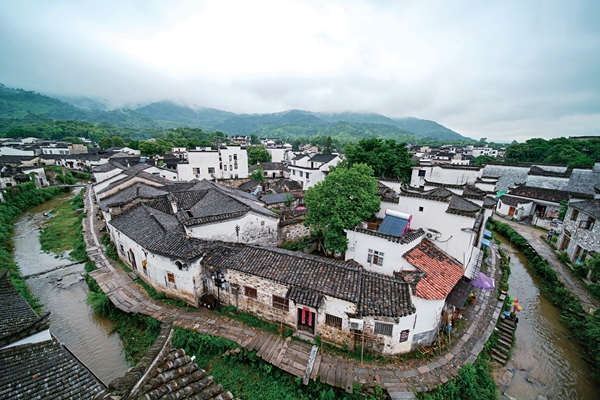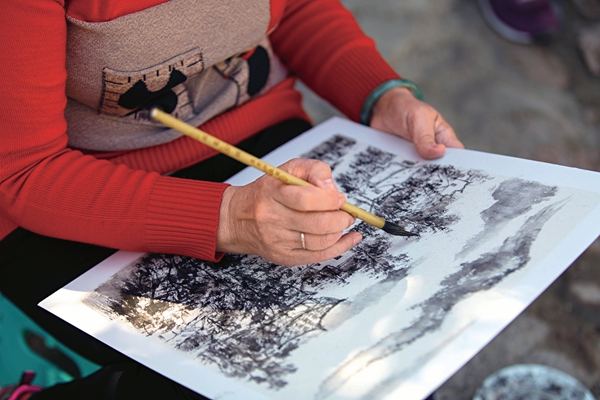Zhaji Ancient Village: Diamond Hidden in Mountains

Zhaji, an ancient village in Taohuatan Town, Jingxian County, in East China's Anhui Province, has nearly 1,400 years of history. Zhaji, also known as the "painters' village," boasts the largest collection of ancient Hui-style architecture in southern Anhui Province.
Located in western Jingxian County, Zhaji Ancient Village was built during the Tang Dynasty (618-907). Zha Wenxi, an official during the Tang Dynasty, was attracted by the natural scenery and geographical conditions of the place, so he and his family moved to Zhaji after his retirement. Zha is regarded as the villagers' ancestor, and most of the villagers are surnamed Zha.
Zhaji is surrounded by four — Danshan, Youshan, Xidishan and Bailing — mountains. Three streams — Xuxi, Cenxi and Shixi — run through the village. The villagers lead a simple and relaxed life, and many still maintain the habit of washing clothes in the streams.
Xuxi stream is considered the village's central axis. The left side of the stream is called Zha Village, and the right side is called Ji Village. Together, they are called Zhaji Village.

The dwellings were built near the mountains, and the village formed along the streams. The layout of Zhaji reflects the wisdom of the ancient people, and the features and essence of traditional Chinese architecture.
The historic buildings integrate perfectly with the surrounding natural environment, together forming a unique traditional cultural environment. Luo Zhewen (1924-2012), a renowned expert in ancient architecture and head of the ancient architecture expert group, under the State Administration of Cultural Heritage, visited Zhaji in 2001. He was amazed by the layout of the village, and by its ancient architecture. Luo suggested the ancient village needed to be better preserved. In June 2001, the village became a key national cultural relics protection unit.
Zhaji is second to none in southern Anhui Province in terms of the scale of ancient dwellings, and it is one of the largest ancient residential complexes extant in China. The village has retained about 200 Hui-style ancient buildings, constructed during the Yuan (1206-1368), Ming (1368-1644) and Qing (1616-1911) dynasties.

The ancient architectures mainly consist of brick and wood structures, with bricks, tiles, stones and wood as the main building materials. The most prominent features of the Hui-style buildings are black tiles, wharf walls and exquisite carvings.
While walking along the time-honored lanes, visitors can appreciate the quaint, yet lively, Hui-style architecture, including the glazed-tile-roofed cottages, solemn ancestral halls, exquisite arch bridges, and well-preserved temples, which promote local culture.
Zhaji is known for its bridges, temples and ancestral halls. Legend has it that Zhaji used to have 108 bridges, 108 temples and 108 ancestral halls. Now, only a few dozen bridges and several temples and ancestral halls exist.

Baogong Ancestral Hall is the biggest ancestral hall. Another of the ancestral halls is Xiaoyou Ancestral Hall. It was built to worship a villager, named Zha Yongliu. His sons were filial, and they knew how to make their parents happy. Now, the ancestral hall is used to promote traditional family virtues in the village.
Since the Tang and Song (960-1279) dynasties, the Zha clan has developed a series of family rules, family instructions and family principles, which mainly focus on filial piety and reverence for ancestors.

More remote and lesser-known than its neighbors, Xidi and Hongcun villages, which were inscribed as UNESCO world heritage sites in 2000, Zhaji is a magnet for artists and art students. The quiet and primitive village is known as the "painters' village," and as the No. 1 village for painting from life.
The village receives numerous artists, photographers and art school students each year to record its fascinating scenery and experience its unique charm. Many artists have established art studios in the village.

Liu Xinsheng, 85, was one of the first several artists who began painting in Zhaji in the 1990s. Regarding Zhaji as an ideal place to create art, he often invited artists to visit the village, and he also invited art school teachers to organize students to paint in the village.
Liu has witnessed the development of Zhaji from a backward village to today's "painters' village." On January 10, 2020, Zhaji Art Museum opened. An exhibition of the works of Liu and two other painters was held that day, to mark the museum's opening.
Along with the growing reputation of the village, the tourism, catering and homestay industries have developed well, and that has helped boost the local economy and increase villagers' incomes.
Photos Supplied by VCG
(Women of China English Monthly December 2022 issue)
Please understand that womenofchina.cn,a non-profit, information-communication website, cannot reach every writer before using articles and images. For copyright issues, please contact us by emailing: website@womenofchina.cn. The articles published and opinions expressed on this website represent the opinions of writers and are not necessarily shared by womenofchina.cn.








.jpg)

 WeChat
WeChat Weibo
Weibo 京公网安备 11010102004314号
京公网安备 11010102004314号